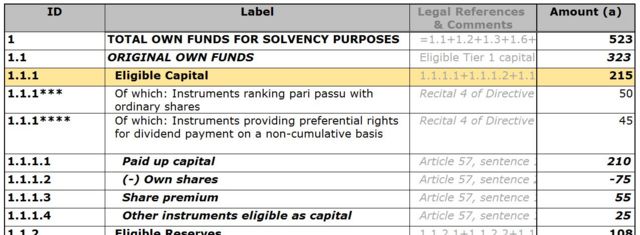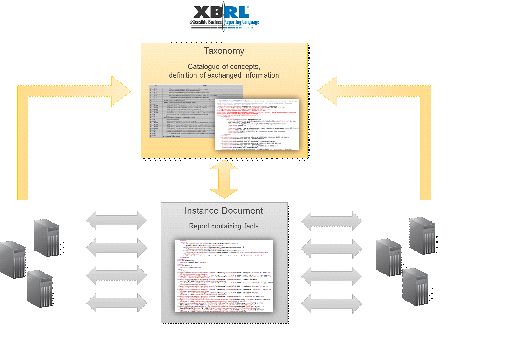European XBRL Reporting Entities handbook
From XBRLWiki
| Revision as of 09:22, 26 November 2012 (edit) Pablo.navarro (Talk | contribs) (→XML) ← Previous diff |
Revision as of 09:30, 26 November 2012 (edit) Pablo.navarro (Talk | contribs) (→XML as a markup language) Next diff → |
||
| Line 107: | Line 107: | ||
| ===XML as a markup language=== | ===XML as a markup language=== | ||
| <span style="background-color:yellow">Explains with simple examples how XML is made of tags</span><br /> | <span style="background-color:yellow">Explains with simple examples how XML is made of tags</span><br /> | ||
| + | |||
| + | Simply put, one can say that XML is a language for the codification of structured information. This coding, which is done via the use of "tags", is the main reason why XML is commonly referred as a markup language. As a basic example, the list below represents a list of books: | ||
| + | |||
| + | <code> | ||
| + | <book>On the Road</book><br /><book>The Catcher in the Rye</book><br /><book>The Hobbit</book><br /><book>The Name of the Rose</book> | ||
| + | </code> | ||
| + | |||
| + | The name of each book is delimited by two marks. The first mark contains an identifier enclosed in angle-brackets (<book>), indicating the beginning of a field. The second mark is equal to the first, but also contains a closing bracket (</book>), which indicates the end of a field. As a result, the content of each element of <book> is delimited by the opening and closing tags. With this method, a system that processes this information can easily identify the subject and aim of the provided information. | ||
| ===XML structures information=== | ===XML structures information=== | ||
Revision as of 09:30, 26 November 2012
CEN Workshop Agreement
Status: Working Group Working Draft
Editing rules
Editorial comments should be highlighted as follows: A comment
Text or rules in discussion (white): Some text
Text or rules already aligned (green): Some text
Text or rules to be deleted (red): Some text
Text to be delivered (blue): Some text
Foreword
This document is a working document.
This document has been prepared by CEN/WS XBRL, the secretariat of which is held by NEN.
This document is a working document.
Introduction
The set of recommendations included in this document aim to facilitate the implementation of European National Supervisors to adopt XBRL in any of the reporting frameworks. The following chapters will provide guidance on the use, understanding, preparation, and extension of their filings in eXtensible Business Reporting Language (XBRL).
This guidance is in the form of notes in association with the pertaining requirements clause and uses the terms “should” (recommendation), “may” (allowance) and “can” (possibility). Organizations wishing to implement this CWA would be expected to consider all recommendations where the term “should”is used.
Scope
COREP, FINREP (and Solvency II or other future) XBRL taxonomies are offered to European regulators for national implementation. The first releases (2006) of the COREP and FINREP XBRL frameworks have proven that a standardized technical roll-out package is needed to increase the adoption rate and avoid implementation variances, which have a detrimental effect on the overall cross-border effectiveness of using one reporting standard. As well this roll-out guide try to promote the economies of scale for a better adoption.
This CWA have divided the work/deliveries in two difference parts:
:i) An XBRL supervisory roll-out guide: this is oriented towards national regulators on how to implement, extend and manage XBRL taxonomies
:ii) An XBRL handbook for declarers: this is a roll-out guide or reference handbook would give a general introduction to XBRL and serve as a help to preparers of XBRL (reporting entities)
The scope of the current document is on the second part of the CWA; the XBRL handbook for declarers. In this general guide to XBRL, the following subjects will be addressed: [DRAFT]
Normative references
The following referenced documents are indispensable for the application of this document. For dated references, only the edition cited applies. For undated references, the latest edition of the referenced document (including any amendments) applies.
EN xyz:199x, Title of the european standard.
EN ab c:199x, General title of series of parts — Part c: Title of part.
Terms and definitions
For the purposes of this document, the following terms and definitions apply / the terms and definitions given in … and the following apply.
- Term1
- description on text for term1
- Term2
- description on text for term2
How to start with XBRL from the declarer's perspective
To be completed adn reviewed
This chapter will introduce filer, declarer and supervised entities in the approach to understand the XBRL standard in the background used by the European Authorities for the reporting information interchange.
Several European National regulators have adopted XBRL as the electronic standard interchange format used in the supervisory and filing environment.
In this case the declarer must follow several steps to cover the reporting requirements using the XBRL Standard.
Higher level of transparency the Regulator put in the use of this electronic format lower effort and investment in declarer’s perspective to comply with the technical reporting requirements (for example in training IT people or hiring specialist companies, adapting software applications, etc., not to mention exploiting the XBRL standard for declarer’s internal reporting information system). The following chapters will introduce and guide the declarer in how to prepare their technical IT teams and departments to understand and cover the use of XBRL standard for supervisory reporting.
There will be cases where software applications and pre-defined tools will be provided to declarer’s to facilitate and isolate the XBRL technical details for their supervised filers information to be reported.
In other cases, where the regulator and the declarer chooses to make full use and exploit of XBRL, the introduction on terminology for XBRL and XML components as it is explained in chapters below is recommended.
XML and XBRL: Introduction to its technological building blocks
This chapter aims to give an overview of the basic technologies that underpin XBRL. Our aim is to give a general introduction of each component in order to obtain a better understanding of this reporting language.
XML
XML, or eXtensible Markup Language, is a W3C standard which enables the representation of structured data in the form of flat text. This simple and flexible text format is both machine readable and human readable. The XML specification, which is a derivative of SGML , uses elements and attributes in order to structure content. Although originally designed for the publication of information, XML is increasingly important in facilitating electronic communications.
In the chapters further below, we'll elaborate on the following topics:
- How XML is a markup language
- How XML enables the structuring of information
- What are the main components of an XML document
- Namespaces and prefixes
- Unicode
- XML benefits
XML as a markup language
Explains with simple examples how XML is made of tags
Simply put, one can say that XML is a language for the codification of structured information. This coding, which is done via the use of "tags", is the main reason why XML is commonly referred as a markup language. As a basic example, the list below represents a list of books:
<book>On the Road</book>
<book>The Catcher in the Rye</book>
<book>The Hobbit</book>
<book>The Name of the Rose</book>
The name of each book is delimited by two marks. The first mark contains an identifier enclosed in angle-brackets (<book>), indicating the beginning of a field. The second mark is equal to the first, but also contains a closing bracket (</book>), which indicates the end of a field. As a result, the content of each element of <book> is delimited by the opening and closing tags. With this method, a system that processes this information can easily identify the subject and aim of the provided information.
XML structures information
Explains XML's hierarchical structures
Components of an XML document
Explain XML elements, root node, and use of <? Xml version = "1.0" encoding = "UTF-8"> opening tag
Namespaces
Explain the use of namespaces: reason, URI, …
Namespaces and prefixes
Explain the use of prefixes (by further elaborating existing example)
UNICODE
Explain unicode
XML Benefits
Sum up and explain basic benefits of xml like; human-readable, self-containing, hierarchical structure, platform independent, …
XML Schemas
Introduce XML schema: definition of XML schema, why it is useful
XML Schema Components
Explain: types, attributes, groups of attributes and elements, importing and including schemas, substitution groups, …
Benefits of using XML Schema
Sum up benefits of XML Schema
XLink
Explain xlink
Technological components used by XML and by XBRL
XPath
Explain xpath
XSLT
Explain xslt
XQuery
Explain xquery
XBRL: Extensible Business Reporting Language
High level description
How to structure reporting data?
Before starting to explain XBRL, we would like to show via an example why the structuring of reported data can be useful. Reported financial data tend to be represented a table format. For example, the COREP Capital Adequacy table looks this:
Such a representation of information is very human-readable. However, it is not ideal for machine interpretation, as it is not very structured. As a result, the following question comes to mind: How can we structure this information, so that it can be transmitted and interpreted in a consistent way? For the purpose of this example, we’ll focus on the “Eligible Capital” line, which is highlighted in yellow in the above example.
A first step would be to tag the amount of Eligible Capital in a way that it is directly linked to the concept of Eligible Capital:
<p-ca:EligibleCapital>215</p-ca:EligibleCapital>
Although this information is already quite structured, some contextual information is missing. Information like the currency of the amount:
<p-ca:EligibleCapital unitRef=”EUR”>215</p-ca:EligibleCapital>
And finally, the reporting period:
<p-ca:EligibleCapital unitRef=”EUR” contextRef=”2012-12-31”>215</p-ca:EligibleCapital>
The above example shows, in a nutshell, how XBRL allows to structure reporting data.
XBRL Introduction
XBRL, or eXtensible Business Reporting Language, is a communication standard developed in order to simplify the exchange of business and financial data.
XBRL normalises the format of data (via the use of XML techniques) en the validation of data (via XBRL taxonomies).
ADD Explanation of the link between taxonomies and instance documents (as pictured above)
XBRL also provides among others:
- Standard validation rules (mathematical and logical rules)
- The use of label linkbases (which allows multi-lingual taxonomies)
- The possibility to provide rendering
- Standard toolset which allow to work with XBRL
During the following chapters we explain XBRL more elaborately. We try to give an insight in the following points: …
XBRL Taxonomies
XBRL taxonomy = "metadata" of reporting data. Taxonomies consist of schema's and relationships or linkbases
Schemas
The schema defines business conept (element of the schema) and basic attributes like: data type, period type, balance attribute, …
Linkbases
Explain linkbases like, label linkbase, presentation linkbase, definition linkbase, calculation linkbase
Extensibility
Taxonomy Extensions
Creating new relationships
Dimensions
The multidimensional model
XBRL dimensions
Formulas
XBRL Reporting: Instance documents
Explain with a practical example how an instance document is constructed…
Validation of XBRL reports
Describe the process of the validation of an instance document: xml validation, xml schema validation, xbrl validations, ….
Bibliography
- [1] :xxx
- [2] :xxx



